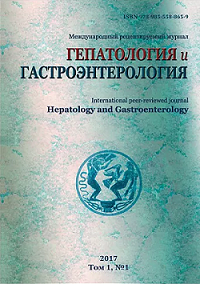OPTIMIZATION OF VACCINE PROPHYLAXIS FOR HBV-INFECTION AMONG CHILDREN AND ADULTS
Abstract
Background. Routine vaccine prophylaxis for HBV infection among newborns and catch-up vaccination of children and adolescents resulted in the reduction in infection rates among children. An urgent task is to reduce the incidence of HBV infection among the adult population.
Objective. To justify the need to change the scheme of preventive immunization of the population against HBV infection in order to increase its effectiveness and reduce the incidence of all forms of HBV infection.
Materials and methods. The effectiveness of vaccine prophylaxis against HBV in 9 children born to HBV-infected mothers and 694 adults, mostly 5th and 6th-year students of the medical university, was evaluated. The titer of specific antibodies (anti-HBs) above 10 IU/ml corresponded to the protective level (ELISA, AmpliSens test system, Russia).
Results. It was found out, that 8 out of 9 children (89%) who had been currently diagnosed with chronic hepatitis B, and who had been born to HBV-infected mothers, did not provide any evidence of the protective efficacy of vaccine prophylaxis. 43% of adults, who had undergone vaccine prophylaxis at the age of 12-13 years, were lacking protective titer of anti-HBs.
Conclusion. The main reason for maintaining a reservoir of HBV infection in the adult population is the lack of immunity to HBV in the age groups over 30. To increase the effectiveness of vaccine prophylaxis for HBV infection in the adult population and children, it is necessary to approbate new schemes of immunization of the population.
References
1. Infekсionnyje bolezni i profilaktika vnutribol´nichnyh infekcij : ucheb. posobije / V. M. Tsyrkunov [et al.]. – Izd. 2-e. – Mn : Asar, 2012. – 847 s. (Russian)
2. Gepatity u detej : diskussija za kruglym stolom [Hepatitis in children: round table discussion] / D. D. Mirutko [et al.] : podgot. T. Jasevich // Healthcare. – 2013. – № 4. – S. 72-75. (Russian)
3. Vakcinoprofilaktika gepatita B [Hepatitis B vaccination prophylaxis] / N. A. Ozeretskovsky [et al.] // Epidemiology and Vaccinal Prevention. – 2015. – T. 14, № 2. – S. 87-95. (Russian)
4. What level of hepatitis B antibody is protective? / A. D. Jack [et al.] // J. Infect. Dis. – 1999. – Vol. 179, iss. 2. – P. 489-492.
5. Persistence of protection against hepatitis B virus infection among adolescents vaccinated with recombinant hepatitis B vaccine beginning at birth: a 15 - year follow-up study / S. R. Bialek [et al.] // Pediatr. Infect. Dis. J. – 2008. – Vol. 27. – P. 881-885. – DOI: 10.1097/INF.0b013e31817702ba.
6. Immunogenicity of hepatitis B vaccines. Implications for persons at occupational risk of hepatitis B virus infection [Immunological and epidemiological effectiveness of hepatitis B vaccination: results of a multicentre study] / F. Averhoff [et al.] // Am. J. Prev. Med. – 1998. – Vol. 15. – P. 1-8.
7. A mathematical model to estimate global hepatitis B disease burden and vaccination impact / S. T. Goldstein [et al.] // Int. J. Epidemiol. – 2005. – Vol. 34. – P. 1329-1339.
8. Immunologicheskaja i epidemiologicheskaja effektivnost´ vakcinacii protiv gepatita B: rezul´taty mnogocentrovogo issledovanija / V. R. Shaginjan [et al.] // Epidemiology and infectious diseases. Current Items. – 2013. – № 4. – S. 20-26. (Russian).
9. Zdorovje naselenija i okruzhajuschaja sreda Grodnenskoj oblasti v 2009 godu [Health of the population and the environment of the Grodno region in 2009] / N. K. Kendysh [et al.]. – Grodno, 2010. – 126 s. (Russian).
10. Puti peredachi vnutribol'nichnyh infekcij. Faktory peredachi vnutribol'nichnyh infekcij. [Elektronnyj resurs]. – Rezhim dostupa: http://medicalplanet.su/443.html. – Data dostupa: 05.02.2016 (Russian).


















1.png)






